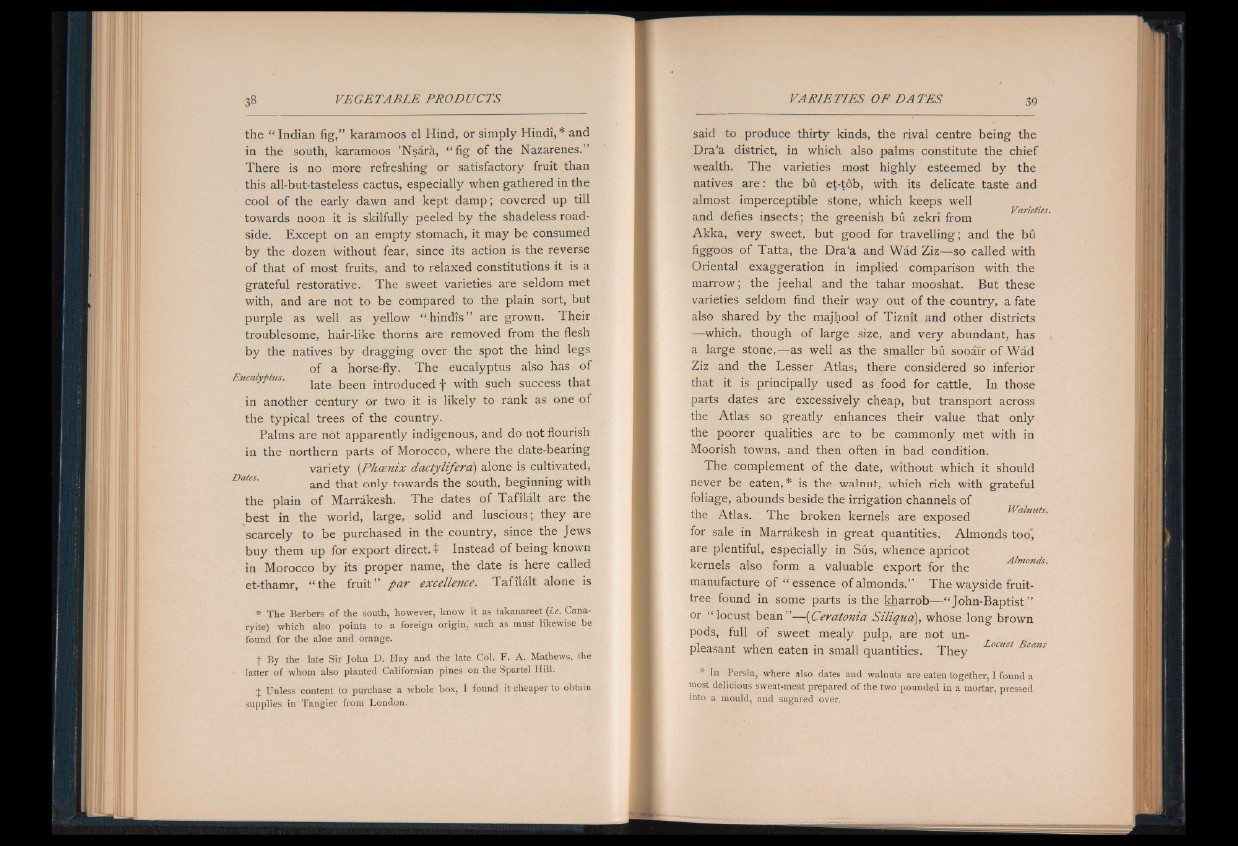
the “ Indian fig,” karamoos el Hind, or simply Hindi,* and
in the south, karamoos ’Nsara, “ fig of the Nazarenes.”
There is no more refreshing or satisfactory fruit than
this all-but-tasteless cactus, especially when gathered in the
cool of the early dawn and kept damp; covered up till
towards noon it is skilfully peeled by the shadeless roadside.
Except on an empty stomach, it may be consumed
by the dozen without fear, since its action is the reverse
of that o f most fruits, and to relaxed constitutions it is a
grateful restorative. The sweet varieties are seldom met
with, and are not to be compared to the plain sort, but
purple as well as yellow “ hindis” are grown. Their
troublesome, hair-like thorns are removed from the flesh
by the natives by dragging over the spot the hind legs
of a horse-fly. The eucalyptus also has of
late been introduced f with such success that
in another century or two it is likely to rank as one of
the typical trees of the country.
Palms are not apparently indigenous, and do not flourish
in the northern parts of Morocco, where the date-bearing
variety (Phoenix dactylifera) alone is cultivated,
Dates' and that only towards the south, beginning with
the plain of Marrakesh. The dates of Tafilalt are the
best in the world, large, solid and luscious; they are
scarcely to be purchased in the country, since the Jews
buy them up for export direct, t Instead o f being known
in Morocco by its proper name, the date is here called
et-thamr, “ the fruit” par excellence. Tafilalt alone is
* The Berbers of the south, however, know it as takanareet (i.e. Cana-
ryite) which also points to a foreign origin, such as must likewise be
found for the aloe and orange.
t By the late Sir John D. Hay and the late Col. F. A. Mathews, the
latter of whom also planted Californian pines on the Spartel Hill.
Unless content to purchase a whole box, I found it-cheaper to obtain
supplies in Tangier from London.
said to produce thirty kinds, the rival centre being the
Dra'a district, in which also palms constitute the chief
wealth. The varieties most highly esteemed by the
natives a re : the bu et-tob, with its delicate taste and
almost imperceptible stone, which keeps well
and defies insects; the greenish bu zekri from
Akka, very sweet, but good for travelling; and the bu
figgoos o f Tatta, the Dra'a and Wad Ziz— so called with
Oriental exaggeration in implied comparison with the
marrow; the jeehal and the tahar mooshat. But these
varieties seldom find their way out of the country, a fate
also shared by the majhool of Tiznit and other districts
— which, though of large size, and very abundant, has
a large stone,— as well as the smaller bu sooair of Wad
Ziz and the Lesser Atlas; there considered so inferior
that it is principally used as.food for cattle. In those
parts dates are excessively cheap, but transport across
the Atlas so greatly enhances their value that only
the poorer qualities are to be commonly met with in
Moorish towns, and then often in bad condition.
The complement o f the date, without which it should
never be eaten,* is the walnut, which rich with grateful
foliage, abounds beside the irrigation channels of
the Atlas. The broken kernels are exposed
for sale in Marrakesh in great quantities. Almonds too’
are plentiful, especially in Sus, whence apricot
kernels also form a valuable export for the
manufacture of “ essence of almonds.” The wayside fruit-
tree found in some parts is the kharrob— “ John-Baptist ”
or “ locust bean”— (Ceratonia Siliqua), whose long brown
pods, full of sweet mealy pulp, are not unpleasant
when eaten in small quantities. They Locust Feans
' la Persia, where also dates and walnuts are eaten together, I found a
most delicious sweat-meat prepared of the two pounded in a mortar, pressed
into a mould, and sugared over.